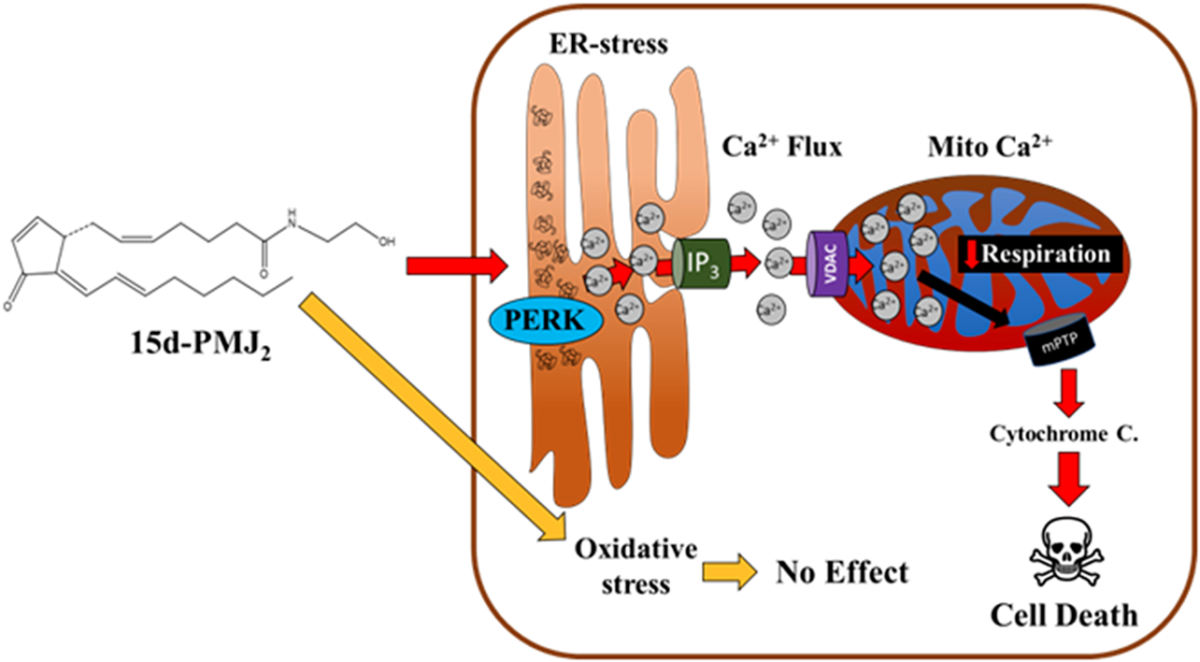“The goal of the present study was to determine the therapeutic potential of 15d-PMJ2 against melanoma by gaining insight into molecular mechanisms underlying its apoptotic activity.”
BUFFALO, NY- January 12, 2023 – A new research paper was published in Oncotarget’s Volume 13 on December 29, 2022, entitled, “Calcium signaling induced by 15-deoxy-prostamide-J2 promotes cell death by activating PERK, IP3R, and the mitochondrial permeability transition pore.”
Melanoma is the deadliest form of skin cancer in the US. Although immunotherapeutic checkpoint inhibitors and small-molecule kinase inhibitors have dramatically increased the survival of patients with melanoma, new or optimized therapeutic approaches are still needed to improve outcomes. 15-deoxy-Δ12,14-prostamide J2 (15d-PMJ2) is an investigational small-molecule that induces ER stress-mediated apoptosis selectively in tumor cells. Additionally, 15d-PMJ2 reduces melanoma growth in vivo.
To assess the chemotherapeutic potential of 15d-PMJ2, researchers Daniel A. Ladin, Margaret M. Nelson, Estefani Cota, Catherine Colonna, Colin Burns, Jacques Robidoux, Kelsey H. Fisher-Wellman, and Rukiyah Van Dross-Anderson from East Carolina University and University of North Carolina at Chapel Hill sought to uncover molecular pathways by which 15d-PMJ2 exerts its antitumor activity.
B16F10 melanoma and JWF2 squamous cell carcinoma cell lines were cultured in the presence of pharmacological agents that prevent ER or oxidative stress as well as Ca2+ channel blockers to identify mechanisms of 15d-PMJ2 cell death.
“Our data demonstrated the ER stress protein, PERK, was required for 15d-PMJ2-induced death.”
PERK activation triggered the release of ER-resident Ca2+ through an IP3R sensitive pathway. Increased calcium mobilization led to mitochondrial Ca2+ overload followed by mitochondrial permeability transition pore (mPTP) opening and the deterioration of mitochondrial respiration. Finally, the researchers showed that the electrophilic double bond located within the cyclopentenone ring of 15d-PMJ2 was required for its activity.
“The present study identifies PERK/IP3R/mPTP signaling as a mechanism of 15d-PMJ2 antitumor activity.”
DOI: https://doi.org/10.18632/oncotarget.28334
Correspondence to: Rukiyah Van Dross-Anderson
Email: vandrossr@ecu.edu
Keywords: calcium, mitochondrial respiration, endoplasmic reticulum stress, cancer, prostamide
ONCOTARGET VIDEOS: YouTube | LabTube | Oncotarget.com
About Oncotarget: Oncotarget (a primarily oncology-focused, peer-reviewed, open access journal) aims to maximize research impact through insightful peer-review; eliminate borders between specialties by linking different fields of oncology, cancer research and biomedical sciences; and foster application of basic and clinical science.
To learn more about Oncotarget, visit Oncotarget.com and connect with us on social media:
- Twitter – https://twitter.com/Oncotarget
- Facebook – https://www.facebook.com/Oncotarget
- YouTube – https://www.youtube.com/@OncotargetJournal
- Instagram – https://www.instagram.com/oncotargetjrnl/
- LinkedIn – https://www.linkedin.com/company/oncotarget/
- Pinterest – https://www.pinterest.com/oncotarget/
- LabTube – https://www.labtube.tv/channel/MTY5OA
- SoundCloud – https://soundcloud.com/oncotarget
For media inquiries, please contact: media@impactjournals.com.
